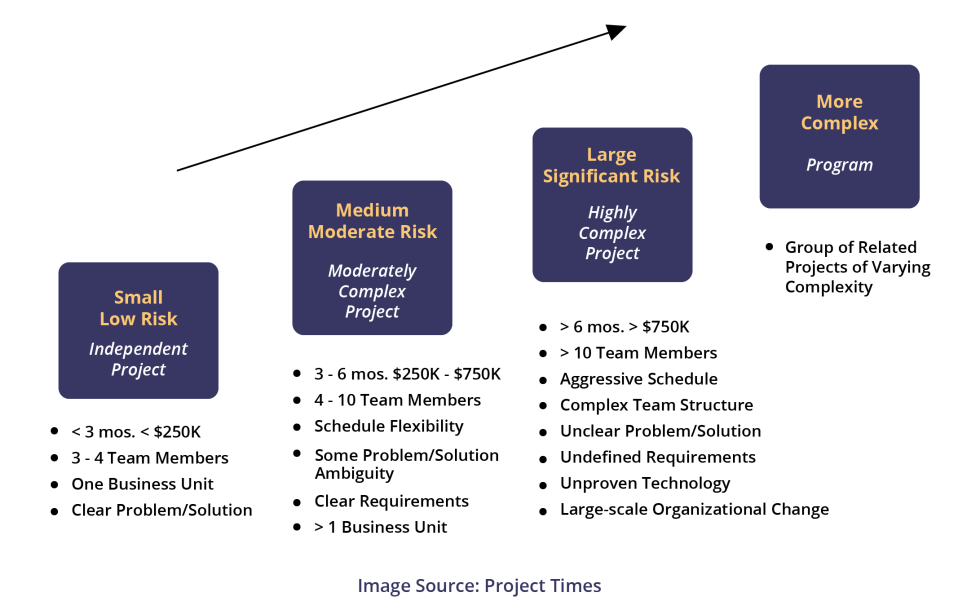It’s tricky being a juggler. Tossing and catching several objects at the same time is both a skill and an art. It requires practice, patience, and the ability to learn from mistakes.
Managing complex projects and delivering them on time is not that different from juggling. You have to balance and handle several issues, stay on top of the schedule, look after your team, the budget, the objectives, the timelines, and much more. As a project manager, you can’t afford to drop even one of them or, the game is over.
Fortunately, there are structured, tried-and-tested ways to address these issues and tackle uncertainties. So, you can deliver a successful performance on time, every time.
What Are Complex Projects?
To begin with, let’s investigate what makes a project complex.
Telling whether a project is complex or can turn into a complex one beforehand, is not always possible. Let us look at some typical characteristics of complicated projects that you should be aware of, to be prepared better.
Factors and Characteristics of Complicated Projects
Complex projects are often made up of a number of smaller projects, under an overall umbrella objective. At other times, the goal may not be clearly defined so you have to work out the steps and deliverables as you go along.
Then again, complexity could creep into a project because of a lack of training, resources, or technology. So, there are various reasons why a project can be complex, and there isn’t one specific sort. In general, complex projects have a high degree of interconnected, interdependent, and interrelated parts.
Project Complexity Models
Many theorists have devised various project complexity models because of the unarguable importance of successful and timely delivery. These models identify interwoven components and relationships. This enables project managers to diagnose the degree of complexity present and apply relevant techniques.

The model above, for example, uses the concept of ‘program management.’ To apply this, you need to diagnose the complexity of various parts of a project, and then focus on the high-risk, highly complex sections. Once those risks and complexities have been managed, the less complex ones can be successfully tackled.
Other models, similar to this one, break a complex project up into parts, classified in terms of low to high risk, and other parameters such as the cost, team, budget, number of stakeholders, and number of goals.
Yet another model, developed at Intel, assesses project characteristics based not only on the above but also historical data on past projects and “what if” scenarios. A high-low score is assigned to each value, and from this, a project complexity score is evaluated.
Manhattan to Mars, Via American Airlines: Interesting Examples of Complex Projects
So far, we’ve been discussing the theory of complex projects. Let’s look at a few real-life examples to bring the issue to life. Some of these are staggeringly complex. Others, less so. However, in each case, the same principles of inter-relatedness, variability, and interdependent parts can be seen.
- The Empire State Building
More than eight decades after its construction, this New York City landmark is still cited as a case study for success. Its construction involved roughly seven million working hours and over 10 million bricks. Yet, it was finished with efficiency and skill. It was completed in 410 days, two weeks ahead of schedule, and about $20 million under budget. The project managers managed a host of different variables admirably. There was just-in-time delivery, a railway system to move materials, cooperation between architects and engineers, advanced planning, quick problem-solving, and superb organizational skills. - American Airlines – When this airline merged with US Airways in 2013, it created an overlap in technology and programs. American Airlines’ spreadsheets were inadequate for managing complex projects and resources, which was financially ineffective. Project managers began using upgraded project management software for time entry, resource management, collaboration, and capacity planning to solve this. This resulted in labor efficiencies, which, in turn, created a multi-million dollar positive impact on the balance sheet, thereby serving as an excellent example of how complexity can be brought down with the right technological solutions. Project requirement management software has led to many such victories.
 Wellingtone’s survey says, only about a fourth of organizations they surveyed, used project management tools. A little more than half of all organizations from the survey didn’t have access to real-time KPIs. Half of all respondents said they spend one or more days manually collate project reports highlighting the immense productivity gains on offer using project management software.
Wellingtone’s survey says, only about a fourth of organizations they surveyed, used project management tools. A little more than half of all organizations from the survey didn’t have access to real-time KPIs. Half of all respondents said they spend one or more days manually collate project reports highlighting the immense productivity gains on offer using project management software. - NASA’s Mars Program – This is a project that’s out of this world, quite literally. It is still ongoing, with the Mars 2020 rover mission set for launch in July 2020. There are overlapping goals, including scientific experiments, the search for a habitable environment, and the quest for microbes. Thus, it’s a hugely complex project with many parts, many objectives, and a defined deadline. To keep costs and risks low, the project design is based on earlier mission architecture and proven landing systems. One lesson to learn from this is to manage complex projects via a mixture of what has worked in the past, combined with adaptability to new factors. To be able to tell what has worked so far and what hasn’t, managers and team leaders must document all the lessons learned from the project.
Read More: Why Project Managers Should Record Lessons Learned
The Six Skills Necessary for Complex Project Management
Clearly, handling a complex project requires significant effort and tactics as compared to handing a project that is routine. The best project managers use a variety of skills and techniques to complete projects of this nature.
Here are six skills that will come in handy
- Adaptability – A complex project is one that is constantly changing. Thus, you need to be adaptable and make dynamic changes and improvements to your project and project operations on the go. Keeping the overall goal in mind, you need to shift tactics and strategies depending on the situation at hand.
- Collaboration – Complex projects need the cooperation of several different people and teams. All of these bring various advantages to the table. All of them have to be handled differently. Therefore, the ability to cooperate is crucial. Seeing others’ points of view and expressing your own are essential steps in creating a win-win situation.
- Communication – In a complex project, the various team members, stakeholders, and management need to be informed of the various points of view when it comes to progress. And all of them, too, will have their opinions. The best way to create an atmosphere of trust and confidence is via effective communication. This is a two-way street that will build relationships for smoother ways of working together.

Expertise – As a project manager, you must constantly draw from your past experiences as well as educate yourself on current and new ones. This will make you the acknowledged expert on the project, and the person whom others will seek when they encounter difficulties. Another aspect of expertise is to recognize which members of your team are specialists in various disciplines and draw upon their skills as and when needed. - Ability to Negotiate – With complex projects, there always has to be an element of give-and-take when it comes to progressing towards objectives. This is important when there are several stakeholders. The art of negotiation is, therefore, an important trump card. This is best done with a knowledge of the overall goal, combined with the needs of those you interact with. The best negotiators make every person feel as though they have been heard.
- Ability to Lead and Motivate – Complex projects are either uncharted territory or peaks that are quite a challenge to scale. There can be many roadblocks. But leaders need to be composed and put forward their best efforts. Effective leadership means that you are motivated and have the ability to motivate others too. For example, in the current hybrid work environment, how will you manage remote teams and keep them motivated throughout the project? That is something as a project manager you should be well-versed with. Author, businessman, and speaker John C. Maxwell says it the best; “A leader is one who knows the way, goes the way, and shows the way.” Guiding and directing your team to the finish line, providing key inputs, and recognizing merit are all invaluable qualities of leadership.
A Preparation Checklist
In an MIT-Sloan magazine article, management professors who had researched mega-projects for a decade came up with the following five principles to keep in mind.
- Assess what’s worked before – This involves learning from similar projects in the past, distilling your own experience as well as looking at case studies.
- Organize for the unforeseen – Here, you must expect changing behavior and shifting elements of risk. Thus, you ought to make room for some flexibility in partnerships and collaboration. It is also a good idea to be absolutely ready with a risk management plan, or a ‘Plan B’ of sorts even.
- Rehearse first – Explore options, look at working models, and improve upon them. Try-outs, simulations, and trials all come in handy here.
- Calibrate and apportion risks – In this step, you ought to balance innovation and standardization when it comes to various outcomes. Try out multiple structures and see which ones can be tweaked for the best results as the project progresses.
- Harness innovation – While fixed structures are essential, can they contain an element of flexibility that encourages innovation to flourish? Also, can these innovations then become standard practice? Asking these questions will enable you to progress efficiently and effectively.
Tips and Techniques on How to Manage Complext Projects
While the above will get you ready to deal with the most complex projects, there are further tips that you can use. After all, you never know what tip borrowed from which project may help you. First, you should keep the overall objective in mind for every step taken. What is the shortest and most effective way to get there? What are the issues you’re likely to face on the way? Then, it makes sense to define specific goals. With complex projects, it’s possible that there could be one main objective which overlaps with others. How would you define these? What are the timelines of each? How do you know when a goal has been successfully achieved?
Of course, as with all projects, you then need to turn your attention towards your team. Do you already have everyone you need? Are there special abilities you need to harness? Once you’re clear about your team, you need to define roles and responsibilities. Communicate with all members and spell out what’s expected from them. Listen to their feedback and make adjustments where needed. Break down the task into smaller steps and let people know where they fit in.
Finally, creating a motivating team environment, especially for a complex project, is very important. Encourage a spirit of openness. Recognize and reward achievements. Help teammates with any issues they may be facing. Make it clear that you need everyone to cooperate.
With these steps, you’ll be able to accomplish and successfully close the most complex of projects.
Closing Complex Projects on Time, Every Time
Deadlines are among the most critical aspects of any project, and more so with complex projects. Preparing a schedule of work, and ensuring that this is done on time, is a significant and essential step.
Here’s how to organize the various tasks and make sure they’re completed in a timely manner.
- First, choose the right tools:
All work items, tasks, and processes should first be identified. It’s best to create a step-by-step scenario so that you’re aware at any point when one task needs to be completed in order for another one to start. You can use Task management software for the same. The Xebrio task management tool, for example, allows you to create tasks, delegate them to teammates, visualize them in a Kanban board, as a classic list, or as individually detailed pages. It also lets you track time and access reports, insights, and analyze efforts spent on tasks.But why this particular tool helps deliver complex projects on time is because it provides much-needed visibility all throughout the lifecycle of the project with the ability to connect tasks to requirements, milestones, and test cases, collaborate with clients, and prioritize & time-track task progress. All of these measures help you monitor each and every aspect of a project, provide risk management and change management, and help your team gain control over a project.

-
- Next, organize a work schedule:
This is a very important document with complex projects. It’s a roadmap that provides direction, lets you review progress, and can be constantly referred to by team members. It is critical for dividing complex projects into manageable parts, completed one after another.
- Next, organize a work schedule:
-
- Monitor progress:
Once work has begun, there should be a monitoring process for each task. This makes sure that everything is progressing according to schedule. Such monitoring reviews should be done on a regular basis, and team members involved should be ready with progress reports.
- Monitor progress:
- Keep reviewing in detail, often:
Finally, with the reviews, you will also be instantly aware of things that are ahead of schedule, or tasks that are falling behind. This will enable you to make adjustments. With complex projects, such aspects can have a cascading effect, so it is key to have this snapshot of overall progress.
You must be thinking, ‘Why do teams miss deadlines?’ They could be talented, hardworking, and cooperative, and yet somehow, the task gets delayed. If you’ve ever asked yourself that question, here are the three reasons you should keep an eye on.
Think of them as tips for managing complex projects.
-
- Optimistic timelines:
It could as well be that everyone has underestimated how long it will take to do something. This could be because of a feeling that everything will go as planned or an inability to factor in unforeseen events. Such improper estimation is common and should be guarded against.
- Optimistic timelines:
-
- Poor time management:
Some studies show that during an 8-hour workday, most people only do 3 hours of productive work. This could be because of frequent meetings, multitasking, socializing, or digital distractions. Perhaps steps need to be taken to reduce these to a minimum.
- Poor time management:
- Stakeholder checkpoints:
Project managers should try and ensure that all stakeholders regularly review progress to see whether the complex project is proceeding according to expectations. Otherwise, if stakeholder inputs come in too late, or if objectives shift, valuable time is lost in redoing work.
When Projects Are Complex, Communication is Critical
As we’ve seen, a complex project has many moving parts. Various people work side by side on multiple issues, they handle different goals, and deadlines and objectives can shift. That is why communication is so important. Every person involved must know his or her roles and responsibilities. As a project manager, you need to be on top of it all, receiving feedback, imparting clarity, and making adjustments.
The Project Management Institute’s in-depth report: Pulse of the Profession (The High Cost of Low Performance: The Essential Role of Communications) found that ineffective communication is the primary contributor to project failure one-third of the time, and harmed project success more than half the time.
In Conclusion
Some projects are simple. Others are not so simple. Some others are extremely challenging. It helps to keep in mind that there is a difference between a complicated project and a complex one. Complex projects tend to be non-linear. They have many subsections and goals, which can overlap. These don’t have to be complicated – the vital thing to remember is that it has to be managed differently.
You need, expertise, skill, and agility for managing complex projects. With some planning in advance, with the right techniques, and with the right software, there’s every reason to expect a successful and on-time delivery.






0 Comments